Resellos on sábanas - Central Mexico (Querétaro, Hidalgo, Estado de México, Puebla, Morelos)
It sgould be noted that apart from the San Juan del Río and Toluca resellos, all these from Central Mexican states were of military origin, and so probably used to validate money paid as wages.
San Juan del Río – Jefatura Politica
‘Jefatura Politica del Partido de San Juan del Rio, Qro’.
San Juan del Río is located on Mexico’s central plateau, 127 kilometres south-east of Querétaro.
On 25 March 1915 in correspondence between the state government and the Administrador Local de Correos over whether or not to accept sábanas the latter complained that no one had been to Querétaro to restamp the notes and no office had been authorised to do the work. 99% of the sábanas in circulation there were unstampedAQ, Fondo Poder Ejecutivo Sec 2ª Hacienda C-1 Año 1915, exp. 167.
San Juan del Rio was captured by the Carrancistas on 9 August 1915.
Tulancingo – Jefatura de Armas
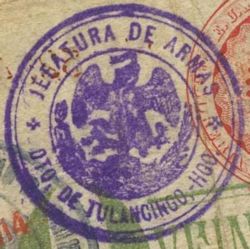 A 33mm circular stamp with ‘JEFATURA DE ARMAS - DTO. DE TULANCINGO, HGO.’ and eagle in centre.
A 33mm circular stamp with ‘JEFATURA DE ARMAS - DTO. DE TULANCINGO, HGO.’ and eagle in centre.
Tulancingo is the second-largest city in Hidalgo, located in the south-eastern part of the state.
Pachuca, the capital of Hidalgo, was captured by the Constitucionalists on 4 August 1914. In October 1914 the Administración Principal de la Renta del Timbre in Pachuca informed the state government that sábanas were of forced circulationPeriódico Oficial, 20 October 1914.
Tulancingo was captured by Convention forces under General J. Mendez on 2 May 1915.
Capula – Jefatura De Armas
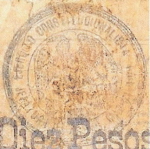 ‘EJÉRCITO CONSTITUCIONALISTA - JEFATURA DE ARMAS, CAPULA, HGO’.
‘EJÉRCITO CONSTITUCIONALISTA - JEFATURA DE ARMAS, CAPULA, HGO’.
Capula is a small town 25 kilometres west of Pachuca.
Hidalgo – Batallón de Zapadores
‘Batallón de Zapadores, Hidalgo’
Zapadores were sappers. In May 1913 Carranza entrusted Capitán Francisco L. Urquizo Benavides with the recruitment and organization of a corps of troops, called the Batallón de Zapadores, because it was made up mostly of workers from the mines of Agujetas, Lampacitos, Cloete and Rosita. In the first days of July, when the Batallón was already about 300 men, Urquizo participated with his unit, under the direct command of General Pablo González, in the recovery of Candela, Coahuila, for which Urquizo was promoted to Major. On 10 July he fought near Monclova at the head of his battalion against a federal column under the command of Colonel Joaquín Maas, hijo and was forced to retreat to San Juan de Sabinas, Coahuila, where he tried to reorganize his battered battalion.
Toluca – Inspección General de Policía
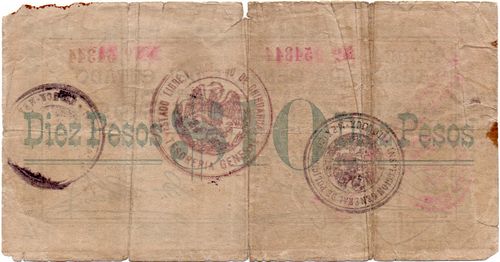
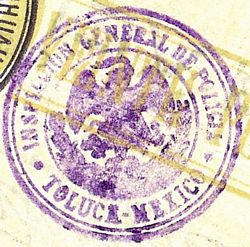 A round (34mm) violet rubber stamp with: ‘INSPECCION GENERAL DE POLICIA - TOLUCA – MEXICO’ and eagle in centre.
A round (34mm) violet rubber stamp with: ‘INSPECCION GENERAL DE POLICIA - TOLUCA – MEXICO’ and eagle in centre.
Toluca is the capital of the state of México, about 63 kilometres west-southwest of Mexico City. It was captured by the second Brigada of the Cuerpo de Ejército Constitucionalista of the División del Noreste, under General Brigadier Francisco Murguia, on 8 August 1914. However, he left Toluca in November 1914 to join Carranza in his flight to Veracruz.
A notice issued by the Inspección General de Policía, dated 29 January 1915, in the names of Inspector Coronel F. Ibarra and Secretario J. M. Arriaga, declared that, amongst others, the Estado de Sonora, sábanas, dos caritas and Ejército Constitucionalista notes were of forced circulation but made no mention of revalidations. However, the Villista issues needed special attention as on 1 February the provisional governor wrote to the Presidente Municipal, recommending that he immediately use the police to ensure that all businesses that had closed establishments reopen them and, at the same time, ensure that Villista notes were accepted, since they were of forced circulation. The next day the Inspector General de Policia, Juan Camacho, reported to the Presidente Municipal that he had given the necessary ordersAMT, sección especial, caja 21, exp. 1014.
In March 1915 when Villista notes stopped circulating in Mexico City they appeared in great numbers in Toluca, particularly the $50 and $100 values. This ‘bad’ money drove out the ‘good’ and Governor Gustavo Baz had to authorise an emergency issue of fractional notesGaceta del Gobierno, 24 March 1915. However, the sábanas were more acceptable than Convention notes or those issued by BazGustavo G. Velazquez, Toluca de Ayer, Mexico, 1972. On 13 April the Governor decided that, until it received an answer as to which notes were of forced circulation, if anyone wanted to pay their taxes with Villista notes, offices should only accept 25% of any payment in such notes. Notices were put up to advise the public (AMT, Presidencia, caja 203, exp. 12). By April 1915 the sábanas had to be revalidated in accordance with with the Convention's decree of 23 January 1915 whilst on 30 June they were declared as being no longer of forced circulationRodolfo Alanis Boyza, Historia de la Revolución en el Estado de Mexico: zapatistas en el poder, Toluca, 1987.
The Carrancistas captured Toluca on 14 October 1915 and the next day invalidated all their opponents’ currency.
Huauchinango – Comandancia Militar
 A purple 41mm round seal with 'COMANDANCIA MILITAR - HUAUCHINANGO, PUE.' and eagle in centre.
A purple 41mm round seal with 'COMANDANCIA MILITAR - HUAUCHINANGO, PUE.' and eagle in centre.
Huauchinango is a city located in the north of the state of Puebla.
Morelos – Ejército Constitucionalista
‘Ejercito Constitucionalista, Morelos’.
[ ] – 2°. Regimiento
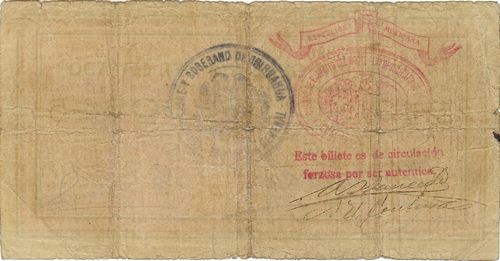
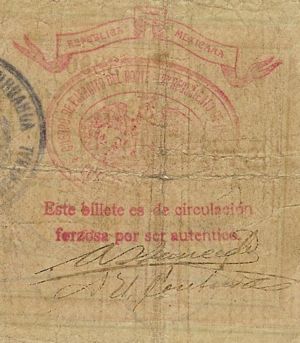 ‘CUERPO DEL EJERCITO DEL NORTE, 2°. REGIMIENTO DE INFANTERIA, CUARTEL GENERAL’ in red or violet oval with ‘REPUBLICA MEXICANA’ in a banner above and ‘Este billete es de circulación forzosa por ser autentico’ and two signatures below.
‘CUERPO DEL EJERCITO DEL NORTE, 2°. REGIMIENTO DE INFANTERIA, CUARTEL GENERAL’ in red or violet oval with ‘REPUBLICA MEXICANA’ in a banner above and ‘Este billete es de circulación forzosa por ser autentico’ and two signatures below.
[ ]
‘Revalidado’ with eagle in centre.
[ ] – Brigada M. Chao
‘Pagaduría General Brigada M. Chao’.
[ ] – Comandancia
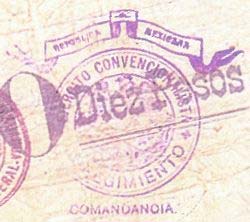 A round stamp with ‘EJERCITO CONVENCIONALISTA – [ ] REGIMIENTO’ and eagle in centre with ‘COMANDANCIA’ below and inscription ‘REPUBLICA MEXICANA’ in scroll above.
A round stamp with ‘EJERCITO CONVENCIONALISTA – [ ] REGIMIENTO’ and eagle in centre with ‘COMANDANCIA’ below and inscription ‘REPUBLICA MEXICANA’ in scroll above.
of unknown origin.
